Coral Springs, FL Pollen and Allergy Report for Summer 2023
Pollen Allergy Trends in Coral Springs, FL
When is pollen lowest in Coral Springs, FL?

May
Lowest month total PPM
Avg. PPM
When is pollen highest in Coral Springs, FL?

April
Highest month total PPM
Avg. PPM
How does pollen in Coral Springs, FL compare to Florida?
Coral Springs has a higher average PPM than the state of Florida.
Coral Springs yearly avg PPM:
Florida yearly avg PPM:
How does pollen in Coral Springs, FL compare to the USA?
Coral Springs has a higher average PPM than the USA.
Coral Springs yearly avg PPM:
USA yearly avg PPM:
Is pollen worse this year in Coral Springs, FL?
Spring 2023 was better than spring 2022.
Spring 2023 PPM:
Spring 2022 PPM:
Average PPM in Coral Springs, FL
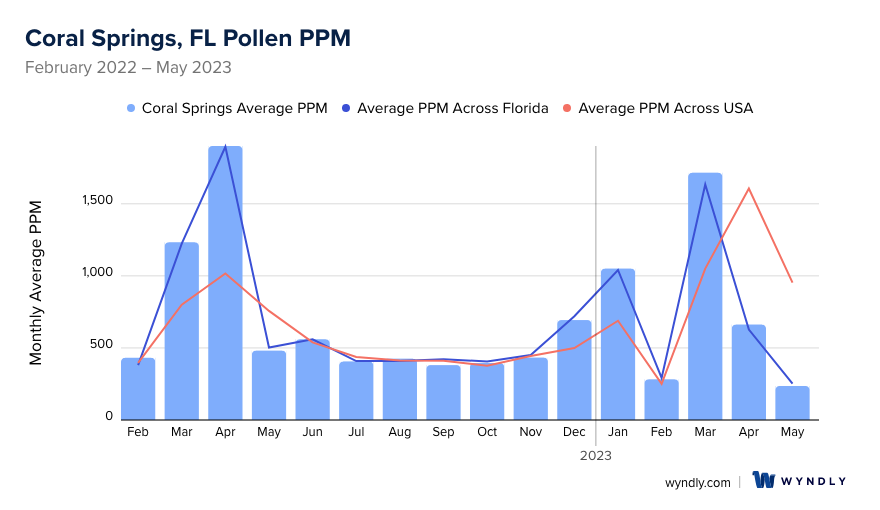
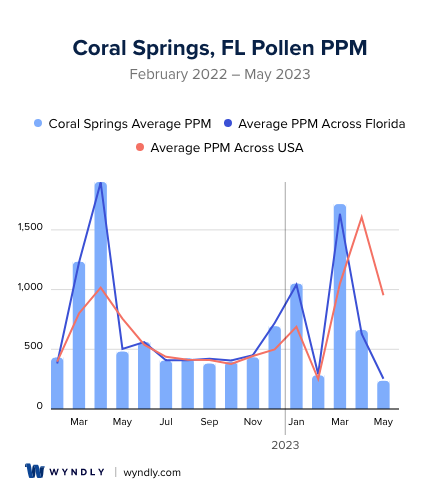
Coral Springs, FL Pollen and Allergy Breakdown by Month
Grass
When is grass pollen highest in Coral Springs, FL?
April has the highest grass pollen in Coral Springs, FL with an average PPM of
When is grass pollen lowest in Coral Springs, FL?
December has the lowest grass pollen in Coral Springs, FL with an average PPM of
Tree
When is tree pollen highest in Coral Springs, FL?
March has the highest tree pollen in Coral Springs, FL with an average PPM of
When is tree pollen lowest in Coral Springs, FL?
July has the lowest tree pollen in Coral Springs, FL with an average PPM of
Weed
When is weed pollen highest in Coral Springs, FL?
June has the highest weed pollen in Coral Springs, FL with an average PPM of
When is weed pollen lowest in Coral Springs, FL?
February has the lowest weed pollen in Coral Springs, FL with an average PPM of
Coral Springs, FL Pollen Monthly Breakdown by Pollen Type
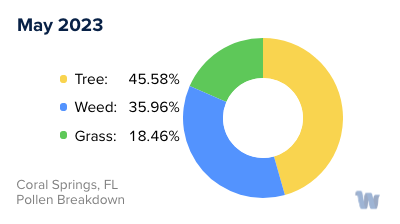
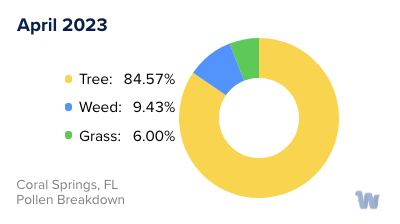
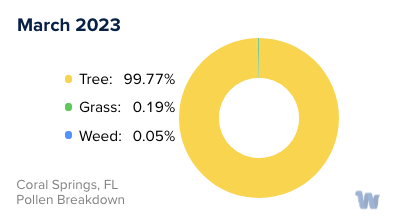
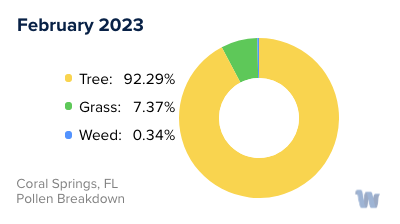
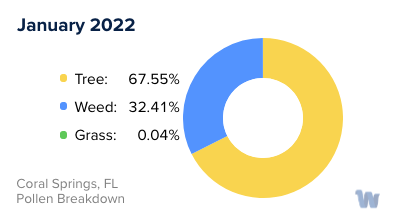
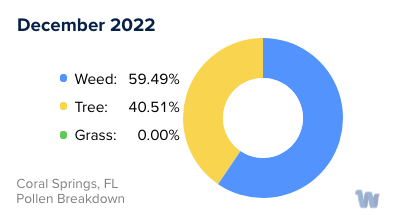
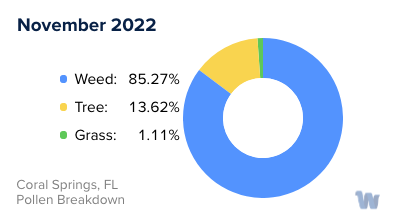
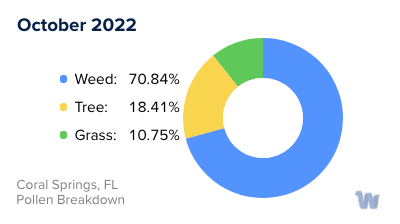
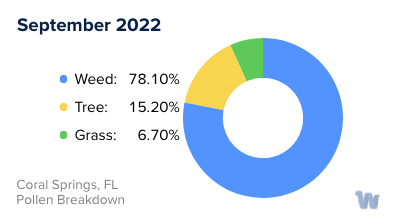
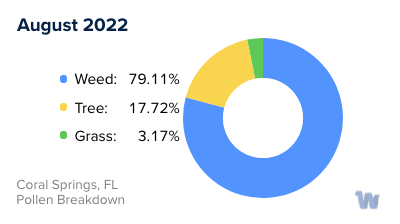
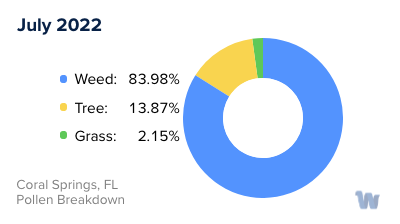
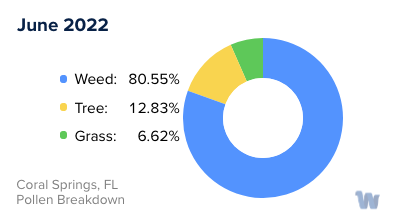

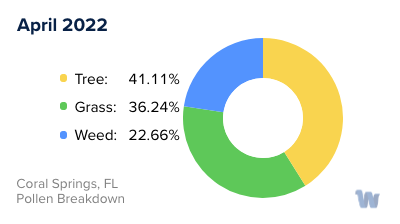
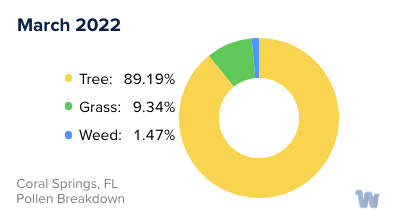
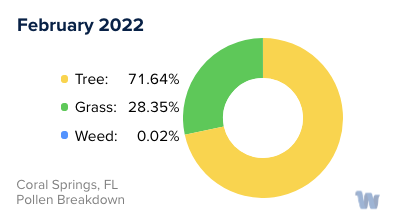
Pollen and Hay Fever in Coral Springs, FL
Pollen allergies, commonly referred to as hay fever, are a prevalent concern in the vibrant city of Coral Springs, Florida. The city's lush vegetation, coupled with its tropical climate, can trigger a range of allergic reactions, particularly in people sensitive to airborne pollen particles.
The primary types of pollen in Coral Springs are tree pollen, grass pollen, and weed pollen. Each type has its unique seasonal pattern, contributing to the year-round potential for pollen allergies.
Tree pollen is primarily released in the spring, with oak, pine, and cedar being the predominant sources. The fresh spring air is often heavy with these microscopic particles, leading to increased instances of hay fever symptoms.
The summer months in Coral Springs herald the onset of grass pollen season. Bermuda grass, Bahia grass, and St. Augustine grass, common in Florida's landscapes, release copious amounts of pollen. During these months, the warm, balmy air carries these allergenic particles, affecting individuals with a sensitivity to grass pollen.
As the summer winds down and the fall season begins, weed pollen takes the lead. The most significant contributor to fall allergies in Coral Springs is ragweed, a plant that thrives in the state's sunny, well-drained soils. This weed can release a staggering amount of pollen, leading to a surge in hay fever cases.
Finally, it's essential to note that although these pollen types have their peak seasons, the mild climate of Coral Springs often allows for extended pollen production cycles. This factor means that pollen allergies can be a year-round issue for some individuals.
To summarize, the diverse flora of Coral Springs, Florida, brings with it a variety of pollen types throughout the year. Recognizing these patterns can help residents anticipate and prepare for each pollen season, even if the city's beauty sometimes brings sneezes and sniffles along with it.


